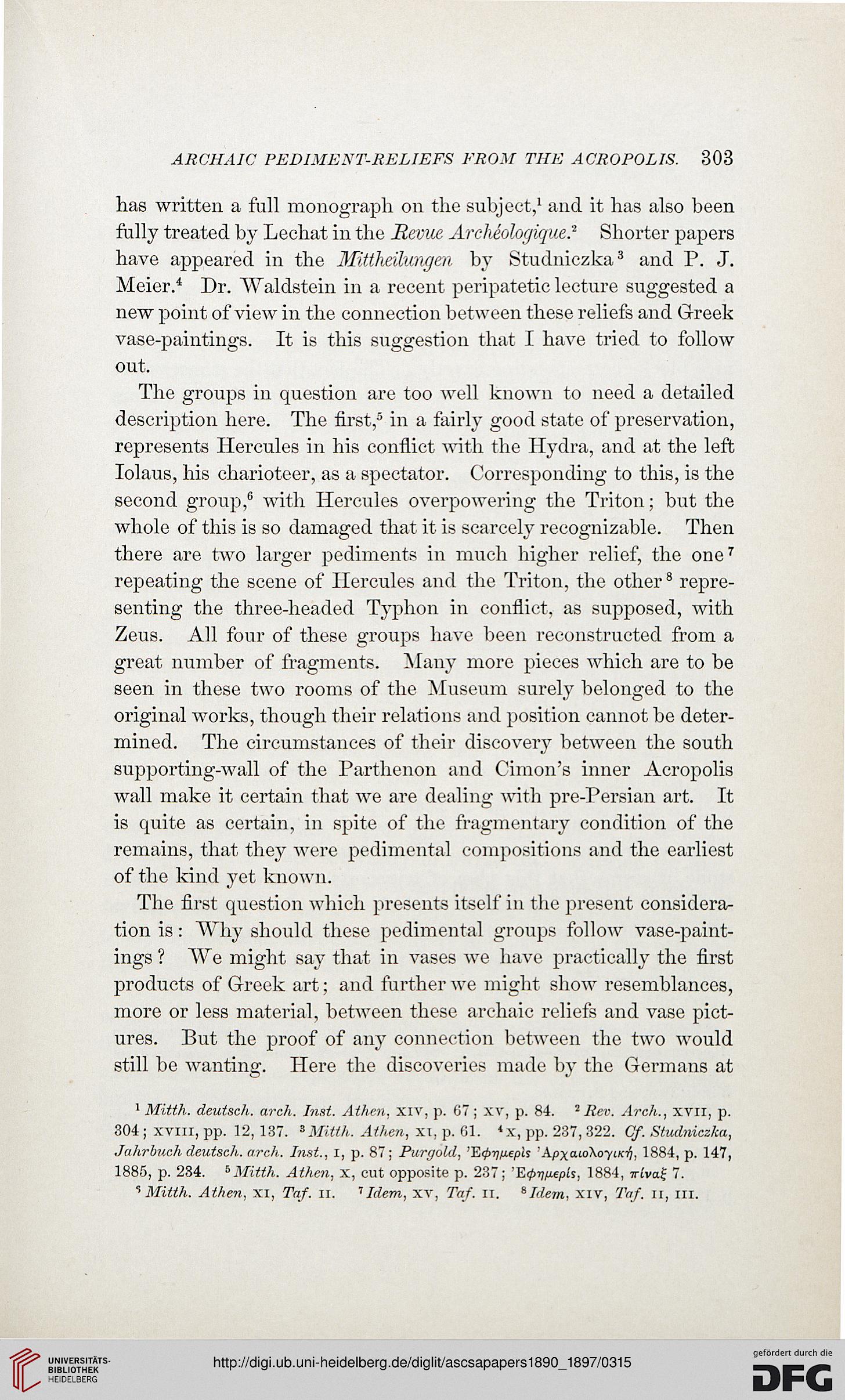ARCHAIC PEDIMENT-RELIEFS FROM THE ACROPOLIS. 303
has written a full monograph on the subject,1 and it has also been
fully treated by Lechat in the Revue Archeologique.2 Shorter papers
have appeared in the Mittheilungen by Studniczka3 and P. J.
Meier.4 Dr. Waldstein in a recent peripatetic lecture suggested a
new point of view in the connection between these reliefs and Greek
vase-paintings. It is this suggestion that I have tried to follow
out.
The groups in question are too well known to need a detailed
description here. The first,5 in a fairly good state of preservation,
represents Hercules in his conflict with the Hydra, and at the left
Iolaus, his charioteer, as a spectator. Corresponding to this, is the
second group,6 with Hercules overpowering the Triton; but the
whole of this is so damaged that it is scarcely recognizable. Then
there are two larger pediments in much higher relief, the one7
repeating the scene of Hercules and the Triton, the other8 repre-
senting the three-headed Typhon in conflict, as supposed, with
Zeus. All four of these groups have been reconstructed from a
great number of fragments. Many more pieces which are to be
seen in these two rooms of the Museum surely belonged to the
original works, though their relations and position cannot be deter-
mined. The circumstances of their discovery between the south
supporting-wall of the Parthenon and Cimon's inner Acropolis
wall make it certain that we are dealing with pre-Persian art. It
is quite as certain, in spite of the fragmentary condition of the
remains, that they were pedimental compositions and the earliest
of the kind yet known.
The first question which presents itself in the {)resent considera-
tion is: Why should these pedimental groups follow vase-paint-
ings ? We might say that in vases we have practically the first
products of Greek art; and further we might show resemblances,
more or less material, between these archaic reliefs and vase pict-
ures. But the proof of any connection between the two would
still be wanting. Here the discoveries made by the Germans at
1 Mitth. deuisch. arch. Inst. Athen, xiv, p. 67; xv, p. 84. 3 Rev. Arch., XVH, p.
304 ; xvin, pp. 12, 137. 'Mitth. Athen, xi, p. Gl. *x, pp. 237, 322. Cf. Studniczka,
Jahrbuch deutsch. arch. Inst., I, p. 87; Purgold, 'E07)jUfpls 'kpxa.Lo\oym7), 1884, p. 147,
1885, p. 234. 6Mitth. Athen, x, cut opposite p. 237; 'KQ-ruitpis, 1884, jrivaf 7.
' Mitth. Athen, xi, Tqf. 11. 7Idem, XV, Taf. 11. sIdem, XIV, Taf. 11, in.
has written a full monograph on the subject,1 and it has also been
fully treated by Lechat in the Revue Archeologique.2 Shorter papers
have appeared in the Mittheilungen by Studniczka3 and P. J.
Meier.4 Dr. Waldstein in a recent peripatetic lecture suggested a
new point of view in the connection between these reliefs and Greek
vase-paintings. It is this suggestion that I have tried to follow
out.
The groups in question are too well known to need a detailed
description here. The first,5 in a fairly good state of preservation,
represents Hercules in his conflict with the Hydra, and at the left
Iolaus, his charioteer, as a spectator. Corresponding to this, is the
second group,6 with Hercules overpowering the Triton; but the
whole of this is so damaged that it is scarcely recognizable. Then
there are two larger pediments in much higher relief, the one7
repeating the scene of Hercules and the Triton, the other8 repre-
senting the three-headed Typhon in conflict, as supposed, with
Zeus. All four of these groups have been reconstructed from a
great number of fragments. Many more pieces which are to be
seen in these two rooms of the Museum surely belonged to the
original works, though their relations and position cannot be deter-
mined. The circumstances of their discovery between the south
supporting-wall of the Parthenon and Cimon's inner Acropolis
wall make it certain that we are dealing with pre-Persian art. It
is quite as certain, in spite of the fragmentary condition of the
remains, that they were pedimental compositions and the earliest
of the kind yet known.
The first question which presents itself in the {)resent considera-
tion is: Why should these pedimental groups follow vase-paint-
ings ? We might say that in vases we have practically the first
products of Greek art; and further we might show resemblances,
more or less material, between these archaic reliefs and vase pict-
ures. But the proof of any connection between the two would
still be wanting. Here the discoveries made by the Germans at
1 Mitth. deuisch. arch. Inst. Athen, xiv, p. 67; xv, p. 84. 3 Rev. Arch., XVH, p.
304 ; xvin, pp. 12, 137. 'Mitth. Athen, xi, p. Gl. *x, pp. 237, 322. Cf. Studniczka,
Jahrbuch deutsch. arch. Inst., I, p. 87; Purgold, 'E07)jUfpls 'kpxa.Lo\oym7), 1884, p. 147,
1885, p. 234. 6Mitth. Athen, x, cut opposite p. 237; 'KQ-ruitpis, 1884, jrivaf 7.
' Mitth. Athen, xi, Tqf. 11. 7Idem, XV, Taf. 11. sIdem, XIV, Taf. 11, in.




